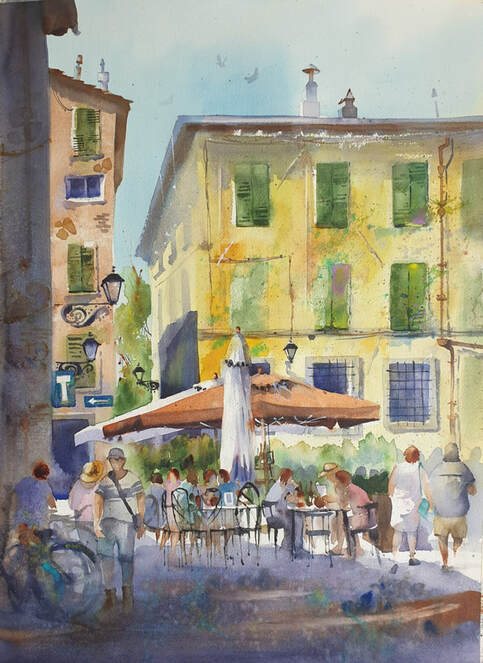 Turquoise Beads Turquoise Beads
#100 (wahoo!)
Learning a new set of skills can be daunting, scary and hard. A big problem for adults coming back to art after many years is high expectations – too high expectations. If you haven’t done any drawing since you were 7, you are likely to be picking up where you left off. Unless you’ve been able to continue your drawing, development is unlikely – you know what it’s like if you haven’t played piano for years (I can’t play my flute anymore, it’s very old and needs maintenance [as do I!] but obviously I haven’t practiced for a long time and my embouchure not up to scratch). Maybe you haven’t played golf for a few years only to return and find your swing is off. Your drawing, painting and creative muscles needs constant attention – regular and frequent SMALL STEPS and exercise. Remember the steps it took for you to learn how to write your name – the dotted letter diagrams we followed? Learning to draw and paint is a similar process, incremental baby steps are required. Many people tell me they can’t draw, I am a firm believer that we are all born creative, however, some of us get the chance (or make the chance) to pursue creative endeavours or maybe your creativity is pursued in a different way. I’m referring to my super creative engineering husband, among many, one of his skills is creating solutions for his clients. More than talent, desire and perseverance are keys to learning and developing a skill in drawing. Few people do not have the ability to learn to draw, if you can sew or knit, play golf, write a letter, you can learn to draw. More important skills are patience and observation along with key tools - time and focus. Time to relax and enjoy the process of creating without the pressure of having to make something. As soon as the artist decides to create a masterpiece – today is the day – it’s all over. Too much pressure makes us focus on all the wrong emotions and decisions, performance anxiety (I’ve only got today to do this), we’re too focussed on the result instead of enjoying the moment and focussing on what the paint is doing on the paper. Whether you want to be a professional artist or you just enjoy the process of creating, it’s important to exercise your creative muscle regularly and frequently – just like a body builder or marathon runner the more you practice the more you can flex your muscles. Poetry in watercolour is made in the freedom of the here and now. ciao bei pittori!!
9 Comments
 Il menu Piazza San Salvatore Lucca Il menu Piazza San Salvatore Lucca
We've had these discussions before, it's not my intent to disrespect other artists but to caution you, my students and friends and help you avoid some traps, especially those of you who wish to build a genuine art practice.
Recently I visited a cafe with lots of art on the walls, every painting was under $100. I then realised all the work was copied from photographs and other artist's work. I know it's not their photos because the subjects were too wide ranging – landscape, still life, portraits and many different birds from all over the world. There were also other improbable subjects and paintings I feel I've seen before. Depth and detail was missing - a level of understanding the artist had failed to perceive because their reference material was substandard, they lacked study and observation. If they had done their own preliminary sketches and workings and took their own photos they would have captured a greater understanding of their subject, form and atmosphere and detail. Of course, will the buyer/viewer notice? who knows? for $100 does it matter? Yes, it takes all sorts and let’s face it, times are not going to get any easier, we all need to put food on the table. But if your goal is to build an authentic art practice, break out the big guns, command higher prices, sell your work in a commercial gallery, it will show and it will matter. My caution is from an authenticity point of view, to help you build a genuine art practice. We don’t all have access to everything to paint. That’s excellent, you like to paint different subject from me, you’re already passionate about a subject that is meaningful to you. For example if you love birds and painting them, I suggest you get a good camera and go take your own reference photos. Go and sketch from life – sketch 1000’s and 1000’s of birds and get good at what you want to do. If you love painting landscapes go and get amongst it. I guess I get a bit antsy about this because I and many artists I know feel they’re doing the hard yards creating original works and series, only for someone to come along and copy. From the first inkling of an idea, some of my work took 3-4 years of brewing, mulling and working before they became a painting and then a series. The reason I bring this all up is because just last week I was asked "does it matter?". How can another artist prove their work is their work? Are we likely to be held up for breach of copyright? Yes it’s a distinct possibility, especially as times get tougher and the internet is more and more clever. If you are painting from other people's reference and photos, your paintings are not your work. More than this, your sketches show your integrity, your commitment to your artistic development and demonstrate a body of work which is your own. The devil is in the detail. Take your own photos (proof), create studies, preliminary sketches and workings (more proof). With a continued course of study you will capture a greater understanding of your subject - form, atmosphere and detail and develop a more interesting and cohesive body of work that is your own, beyond question. non ferma cari amici!! From TS Eliot TS Eliot once said “Immature poets imitate; mature poets steal; bad poets deface what they take, and good poets make it into something better, or at least something different. The good poet welds his theft into a whole of feeling which is unique, utterly different from that which it was torn”.  Custard Square Bookshop, Christchurch, New Zealand Custard Square Bookshop, Christchurch, New Zealand
Jude asked:
Do you always plan out everything ie... colours for everything and where bikes, cones etc might go? Yes I do plan everything out BUT as I'm a little haphazard (read Arty-Farty - aka rip sh*t and bust!) I'm also happy to let go and see where the "unplan" takes me. So sometimes my painting is not like my sketch (sometimes my sketches are not like the scene!!). You know that I pretty much always map out my design in a thumbnail sketch first. This sketch is about studying the pattern of the light and the dark and working out a composition. It's not about detail. I'm working out how I can use them to move the viewers eye around the painting. this sketch also helps me to learn about the scene/subject, it helps me to discover areas that could become a problem, or elements that I can take advantage of eg interlocking and overlapping shapes. I make a "shopping list" of elements in the scene that I may or may not want to add into my painting and choose the ones that I like or help me to tell my story. Once I've drawn my map onto my watercolour paper, I sometimes find there are areas that could be utilised or need a little filling up, these ideas come from my shopping list. with regard to palette selection, I'm often smitten with a particular palette for a year or two and then replace a pigment or two. I usually use the same foundation palette for my realism work, based on transparent primary pigments, just the three plus burnt sienna, the same three I recommend to beginners. These colours will mix into every colour you could possibly need - just as well if you're in lockdown and no art supply store!! Divertiti tutti!! |
AuthorPaintBox Tips, secrets, random thoughts, Poetry in watercolour is made in the freedom of the here and now. Amanda Brett Inspiration exists, but it has to find you working - Pablo Picasso There are no mistakes in watercolour, just some extra surprises!! Categories
All
What my readers and viewers have to say
Your emails are so informative! I must confess I've watched a couple of your demos from beginning to end, and it makes me want to watercolor!!! I've only ever painted with oil or acrylics and haven't know how to begin with WC. Your content is excellent!
Susan VN Hi Amanda
Thank you for your tips. They inspired me to practise and I realised I haven’t been loading the brush properly. I learnt about adding more paint, and not water, to washes. In today’s tips I like the idea of painting with purpose. Your tips are very helpful. I very much appreciate receiving them. Elizabeth Hi Amanda I enjoyed your post and generous tips. Looked up Dan Burt I begin to see that you can colour any subject to give it pizazz so long as the tone and form is correct Certainly adding value now to my attempts Thanks heaps Annie
Yes very wise words. Agree with not fussing and agree with comments about good quality paint. Well written and inspirational as always. Cheers Janet xxxx Archives
July 2023
Copyright © 2022 All images and text on Amanda's blog and website are the the legal property of Amanda Brett and may not be reproduced without express permission from Amanda Brett or her authorised agent. Thank you for respecting her art and the livelihood of all artists.
|



